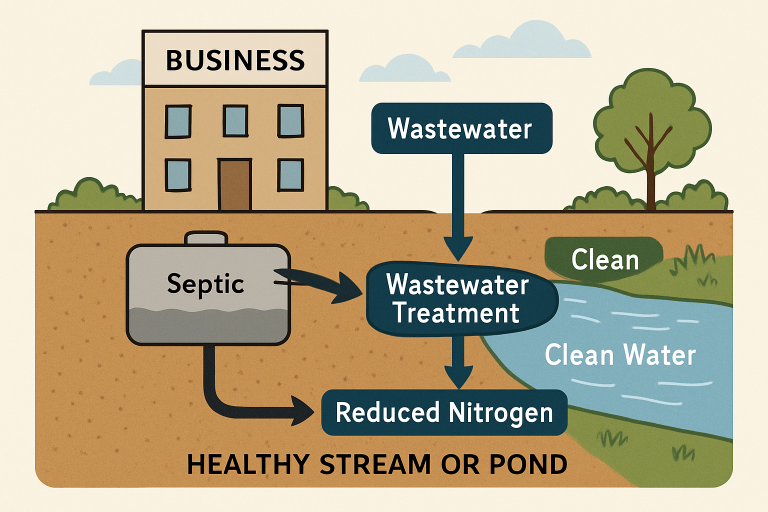Introduction to Nitrogen Pollution and Its Impact
Across the United States, nitrogen pollution has become a significant environmental concern, directly affecting water quality, aquatic life, and human health. Excess nitrogen seeps into waterways, fueling algal blooms, oxygen depletion, and fish kills that can devastate local economies and threaten drinking water supplies. For businesses operating in sensitive regions, an effective response is crucial for maintaining sustainable operations and ensuring regulatory compliance.
Innovative solutions, such as nitrogen-reducing septic system, are becoming indispensable, particularly for companies in coastal states or areas with stringent water protection mandates. By minimizing nitrogen discharge at the source, businesses play a crucial role in safeguarding natural resources and ensuring responsible environmental stewardship.
The Role of Septic Systems in Nitrogen Discharge
Septic systems treat and dispose of wastewater on-site for millions of businesses and homes, particularly in rural and suburban areas. Standard systems, however, typically have minimal capacity to remove nitrogen. Wastewater containing nitrogen compounds can quickly infiltrate soil and leach into groundwater, eventually reaching rivers and coastal waters where the cumulative impact magnifies over time. Chronic nutrient loads are often associated with declining water quality and increased regulatory scrutiny.
Modernizing outdated septic technology enables businesses to address their direct environmental impact. For establishments requiring scalable solutions for multiple users, a commercial septic solution is often the best approach for larger-scale operations.
Advancements in Nitrogen-Reducing Septic Technologies
Recent technological advancements make it feasible for businesses to adopt affordable and efficient nitrogen-reducing solutions. For example, field tests conducted by the U.S. Geological Survey in Massachusetts have demonstrated that carbon-amended media in septic systems can reduce wastewater nitrogen loading by more than 90%. These systems utilize biological processes to convert nitrogen into harmless gases, which are then safely released into the atmosphere, rather than accumulating in groundwater. Other approaches include advanced treatment units and engineered wetlands, each of which is selected based on local needs and regulatory requirements.

Benefits of Implementing Nitrogen-Reducing Systems
- Environmental Protection: Advanced systems filter out excess nitrogen before it enters the environment, reducing the risk of ecosystem damage and contaminated drinking water. According to the EPA, adopting source-control and advanced septic technologies can significantly minimize nitrogen pollution, helping protect both local waterways and community health.
- Regulatory Compliance: The installation of certified nitrogen-reducing technologies enables businesses to meet their legal obligations and avoid costly penalties for non-compliance.
- Community Relations: Proactive investment in sustainable infrastructure boosts corporate reputation, fosters public goodwill, and supports relationships with residents and governmental agencies.
- Operational Longevity: Enhanced waste management extends the operational life of septic systems, typically resulting in fewer maintenance interventions and lower long-term costs.
Steps for Businesses to Transition
- Assessment: Start with a professional evaluation of the current septic system infrastructure and its environmental impact. This review identifies vulnerabilities and opportunities to upgrade.
- Research: Carefully evaluate different nitrogen-reducing technologies and solutions, selecting those that meet your industry’s needs, location, and growth forecasts.
- Consultation: Partner with qualified environmental engineers and wastewater experts to develop a tailored implementation plan that aligns with both your operational and environmental objectives.
- Implementation: Engage skilled contractors to install the selected system and ensure it meets all relevant state and federal standards for performance and safety.
- Monitoring: Schedule regular inspections and water quality tests to verify ongoing effectiveness. Monitoring records help demonstrate compliance and support continuous improvement efforts.
Conclusion
Adopting nitrogen-reducing septic systems positions businesses as leaders in environmental responsibility while ensuring smooth compliance with a constantly evolving regulatory landscape. By proactively investing in advanced treatment solutions, companies not only lessen their environmental footprint but also contribute to the health and well-being of their communities—ultimately securing their operational success in today’s sustainability-driven marketplace.















